Simulation of Groundwater Flow Dynamics under Different Stresses Using MODFLOW in Rechna Doab, Pakistan
Abstract
:1. Introduction
2. Materials and Methods
2.1. Description of the Study Area
2.2. Data Acquisition
2.3. Model Development Section
2.3.1. Defining Modelling Objectives
2.3.2. Collection of Data Objects
2.3.3. Layer Development
2.3.4. Model Structure
2.4. Hydrogeological Properties
2.4.1. Derivation of the Horizontal Hydraulic Conductivity (Kh)
2.4.2. Derivation of the Vertical Hydraulic Conductivity (Kv)
2.5. Initial Hydraulic Head
2.6. Boundary Conditions
2.7. Spatial Discretization
2.8. Defining Observation Wells
2.9. Transient Model Development (Time-Variant Data)
2.9.1. Derivation of Specific Yield (Sy)
2.9.2. Recharge
2.10. Model Calibration and Validation
2.11. Statistical Analysis
2.11.1. Root Mean Square Error
2.11.2. Normalized Root Mean Square Error
2.11.3. Standard Error of Estimate
2.11.4. Correlation Coefficient
2.11.5. Mean Absolute Error
2.11.6. Nash–Sutcliffe Efficiency
2.11.7. Coefficient of Determination
2.12. Future Scenario Analysis
2.12.1. Scenario I: Business as Usual
2.12.2. Scenario II: Increased Groundwater Pumping Following the Historical Trend
2.12.3. Scenario III: Spatially Adjusted Surface Water Supplies and Pumping Pattern
3. Results and Discussion
3.1. Steady-State Model Calibration
3.2. Transient-State Model Calibration
3.3. Model Validation
3.4. Results of Future Scenario I
3.5. Scenario II (Historical Trend of Pumping)
3.6. Scenario III (Spatially Adjusted Irrigation Recharge and Pumping)
4. Conclusions and Recommendations
- •
- Due to its importance from the agricultural perspective, the Lower Chenab Canal Command Area is vital and contributes a lot to the country’s gross domestic product.
- •
- The area’s aquifer is highly stressed and requires immediate attention in regard to recharge and pumping patterns.
- •
- A future-scenario-based, three-layer groundwater flow model was developed, which gave satisfactory results regarding aquifer storage and releases.
- •
- Calibration of the model using 160 observations of groundwater levels gives a relatively good fit with a SEE of 0.15–0.18 m and a RMSE of 1.8–2.2 m.
- •
- The future scenario results under the business-as-usual scenario revealed that there was a net gain of water levels in the upper parts of the study area with a maximum increase of 5 m, whereas a lowering of water levels was predicted in the central and lower parts, with a maximum drop of 5.17 m.
- •
- For Scenario II, which followed the historical trend of pumping in the complete LCC-E, an overall decline in water levels was observed, with a minimum decline of 6.03 m and a maximum decline of 15.68 m.
- •
- The water levels for the spatially adjusted recharge and discharge patterns under the future management Scenario III gave new water dynamics with a maximum drawdown of 10.7 m and a maximum recovery of 7.99 m in water levels.
- •
- Utilizing the underlying unconfined aquifer of the study area as a water storage reservoir as it has an enormous potential to store water, especially during the high flow season of the river and the monsoon period. The shallow aquifer must be recharged artificially.
- •
- Reallocating the surface water supplies to avoid waterlogging in the upper parts of the LCC and lower water levels in the lower portions. This can be achieved by shifting 30% of canal water supplies from the upper to the lower regions. This reduction in supplies for the upper parts could be compensated by additional pumping, whereas the lower parts would be able to reduce pumping in the same proportion as receiving more canal supplies. This would allow the water levels to recover in the study area.
- •
- The artificial recharging of the aquifer through flood-water spreading and ponding through rainwater harvesting in the depressions can be very effective in highly stressed areas.
- •
- Implementing proper pumping and groundwater management policy legislation in the study area to sustainably safeguard precious groundwater resources.
5. Limitations of the Study
Author Contributions
Funding
Institutional Review Board Statement
Informed Consent Statement
Data Availability Statement
Acknowledgments
Conflicts of Interest
References
- Barlow, M.; Clarke, T. Blue Gold: The Battle against Corporate Theft of the World’s Water; Routledge: London, UK, 2017. [Google Scholar]
- Bogardi, J.J.; Bharati, L.; Foster, S.; Dhaubanjar, S. Water and its management: Dependence, linkages and challenges. In Handbook of Water Resources Management: Discourses, Concepts and Examples; Springer: Berlin/Heidelberg, Germany, 2021; pp. 41–85. [Google Scholar]
- Benz, S.A.; Bayer, P.; Blum, P. Global patterns of shallow groundwater temperatures. Environ. Res. Lett. 2017, 12, 034005. [Google Scholar] [CrossRef]
- Gleeson, T.; Wada, Y.; Bierkens, M.F.; van Beek, L.P. Water balance of global aquifers revealed by groundwater footprint. Nature 2012, 488, 197. [Google Scholar] [CrossRef] [PubMed]
- Qadir, M.; Boers, T.M.; Schubert, S.; Ghafoor, A.; Murtaza, G. Agricultural water management in water-starved countries: Challenges and opportunities. Agric. Water Manag. 2003, 62, 165–185. [Google Scholar] [CrossRef]
- Sun, H.; Zhang, X.; Wang, E.; Chen, S.; Shao, L. Quantifying the impact of irrigation on groundwater reserve and crop production–A case study in the North China Plain. Eur. J. Agron. 2015, 70, 48–56. [Google Scholar] [CrossRef]
- Mirzaei, A.; Saghafian, B.; Mirchi, A.; Madani, K. The groundwater-energy-food nexus in Iran’s agricultural sector: Implications for water security. Water 2019, 11, 1835. [Google Scholar] [CrossRef] [Green Version]
- Shah, T. The groundwater economy of South Asia: An assessment of size, significance and socio-ecological impacts. In The Agricultural Groundwater Revolution: Opportunities and Threats to Development; CAB International: Oxford, UK, 2007; pp. 7–36. [Google Scholar]
- Choudhary, M.R. Optimal Conjunctive Use of Surface and Groundwater in a Watercourse Command Area of the Indus Basin. Ph.D. Thesis, Colorado State University, Fort Collins, CO, USA, 1989. [Google Scholar]
- Muzammil, M.; Zahid, A.; Breuer, L. Water Resources Management Strategies for Irrigated Agriculture in the Indus Basin of Pakistan. Water 2020, 12, 1429. [Google Scholar] [CrossRef]
- Qureshi, A.S. Groundwater Governance in Pakistan: From Colossal Development to Neglected Management. Water 2020, 12, 3017. [Google Scholar] [CrossRef]
- Bakhsh, A.; Awan, Q. Water issues in Pakistan and their remedies. In Proceedings of the National Symposium on Drought and Water Resources, Lahore, Pakistan, 16 March 2002; pp. 145–150. [Google Scholar]
- MoWP. Handbook on Water Crisis of Pakistan; Ministry of Water and Power: Islamabad, Pakistan, 2012.
- Ashraf, A.; Ahmad, Z.; Akhter, G. Monitoring groundwater flow dynamics and vulnerability to climate change in Chaj Doab, Indus Basin, through modeling approach. In Groundwater of South Asia; Springer: Berlin/Heidelberg, Germany, 2018; pp. 593–611. [Google Scholar]
- Qureshi, A.S. Water management in the Indus basin in Pakistan: Challenges and opportunities. Mt. Res. Dev. 2011, 31, 252–260. [Google Scholar] [CrossRef]
- MacDonald, A.; Bonsor, H.; Ahmed, K.; Burgess, W.; Basharat, M.; Calow, R.; Dixit, A.; Foster, S.; Gopal, K.; Lapworth, D. Groundwater quality and depletion in the Indo-Gangetic Basin mapped from in situ observations. Nat. Geosci. 2016, 9, 762–766. [Google Scholar] [CrossRef] [Green Version]
- Jabeen, M.; Ahmad, Z.; Ashraf, A. Predicting behaviour of the Indus basin aquifer susceptible to degraded environment in the Punjab province, Pakistan. Model. Earth Syst. Environ. 2020, 6, 1633–1644. [Google Scholar] [CrossRef]
- Khan, A.; Iqbal, N.; Ashraf, M.; Sheikh, A.A. Groundwater Investigations and Mapping in the Upper Indus Plain; Pakistan Council of Research in Water Resources (PCRWR): Islamabad, Pakistan, 2016. [Google Scholar]
- Ashraf, A.; Ahmad, Z. Regional groundwater flow modelling of Upper Chaj Doab of Indus Basin, Pakistan using finite element model (Feflow) and geoinformatics. Geophys. J. Int. 2008, 173, 17–24. [Google Scholar] [CrossRef] [Green Version]
- Bhutta, M.N.; Smedema, L.K. One hundred years of waterlogging and salinity control in the Indus valley, Pakistan: A historical review. Irrig. Drain. 2007, 56, S81–S90. [Google Scholar] [CrossRef]
- Gómez, C.; Green, D.R. Small unmanned airborne systems to support oil and gas pipeline monitoring and mapping. Arab. J. Geosci. 2017, 10, 1–17. [Google Scholar] [CrossRef] [Green Version]
- PBOS. Agriculture Statistics of Pakistan; Statistics Division, Government of Pakistan: Islamabad, Pakistan, 2010–2011.
- Shahab, A.; Shihua, Q.; Rashid, A.; Hasan, F.U.; Sohail, M.T. Evaluation of Water Quality for Drinking and Agricultural Suitability in the Lower Indus Plain in Sindh Province, Pakistan. Pol. J. Environ. Stud. 2016, 25, 2563–2574. [Google Scholar] [CrossRef] [PubMed]
- Bhatti, M.T.; Anwar, A.A.; Aslam, M. Groundwater monitoring and management: Status and options in Pakistan. Comput. Electron. Agric. 2017, 135, 143–153. [Google Scholar] [CrossRef]
- Zulfiqar, F.; Thapa, G.B. Agricultural sustainability assessment at provincial level in Pakistan. Land Use Policy 2017, 68, 492–502. [Google Scholar] [CrossRef]
- Ahmed, K.; Shahid, S.; Demirel, M.C.; Nawaz, N.; Khan, N. The changing characteristics of groundwater sustainability in Pakistan from 2002 to 2016. Hydrogeol. J. 2019, 27, 2485–2496. [Google Scholar] [CrossRef]
- Van der Wal, M.M.; De Kraker, J.; Kroeze, C.; Kirschner, P.A.; Valkering, P. Can computer models be used for social learning? A serious game in water management. Environ. Model. Softw. 2016, 75, 119–132. [Google Scholar] [CrossRef]
- Basco-Carrera, L.; Warren, A.; van Beek, E.; Jonoski, A.; Giardino, A. Collaborative modelling or participatory modelling? A framework for water resources management. Environ. Model. Softw. 2017, 91, 95–110. [Google Scholar] [CrossRef]
- El Osta, M. Maximizing the management of groundwater resources in the Paris–Abu Bayan reclaimed area, Western Desert, Egypt. Arab. J. Geosci. 2018, 11, 1–20. [Google Scholar]
- Khadri, S.; Pande, C. Ground water flow modeling for calibrating steady state using MODFLOW software: A case study of Mahesh River basin, India. Model. Earth Syst. Environ. 2016, 2, 39. [Google Scholar] [CrossRef]
- Siade, A.; Rathi, B.; Prommer, H.; Welter, D.; Doherty, J. Using heuristic multi-objective optimization for quantifying predictive uncertainty associated with groundwater flow and reactive transport models. J. Hydrol. 2019, 577, 123999. [Google Scholar] [CrossRef]
- Anderson, M.P.; Woessner, W.W.; Hunt, R.J. Applied Groundwater Modeling: Simulation of Flow and Advective Transport; Academic press: Cambridge, MA, USA, 2015. [Google Scholar]
- Masoud, M.H.; Schneider, M.; El Osta, M. Recharge flux to the Nubian Sandstone aquifer and its impact on the present development in southwest Egypt. J. Afr. Earth Sci. 2013, 85, 115–124. [Google Scholar] [CrossRef]
- White, J.T. Forecast first: An argument for groundwater modeling in reverse. Groundwater 2017, 55, 660–664. [Google Scholar] [CrossRef] [PubMed]
- Malenica, L.; Gotovac, H.; Kamber, G.; Simunovic, S.; Allu, S.; Divic, V. Groundwater flow modeling in karst aquifers: Coupling 3d matrix and 1d conduit flow via control volume isogeometric analysis—Experimental verification with a 3D physical model. Water 2018, 10, 1787. [Google Scholar] [CrossRef] [Green Version]
- Basharat, M.; Tariq, A.-U.-R. Command-scale integrated water management in response to spatial climate variability in Lower Bari Doab Canal irrigation system. Water Policy 2014, 16, 374–396. [Google Scholar] [CrossRef]
- Sarwar, A. A Transient Model Approach to Improve on-Farm Irrigation and Drainage in Semi-Arid Zones; International Water Management Institute (IWMI): Lahore, Pakistan, 2000. [Google Scholar]
- Sarwar, A.; Eggers, H. Development of a conjunctive use model to evaluate alternative management options for surface and groundwater resources. Hydrogeol. J. 2006, 14, 1676–1687. [Google Scholar] [CrossRef]
- Mujtaba, G.; Ahmed, Z.; Ophori, D. Management of groundwater resources in Punjab, Pakistan, using a groundwater flow model. J. Environ. Hydrol. 2007, 15, 1–14. [Google Scholar]
- Khan, S.; Rana, T.; Ullah, K.; Christen, E.; Nafees, M. Investigating Conjunctive Water Management Options Using a Dynamic Surface-Groundwater Modelling Approach: A Case Study of Rechna Doab; Report No 35/03; CSIRO: Canberra, Australia, 2003. [Google Scholar]
- Jehangir, W.A.; Qureshi, A.S.; Ali, N. Conjunctive Water Management in the Rechna Doab: An Overview of Resources and Issues; IWMI: Lahore, Pakistan, 2002; Volume 48. [Google Scholar]
- PMD. Climate and Astronomical Data. Available online: http://www.pmd.gov.pk/ (accessed on 10 September 2018).
- Usman, M.; Liedl, R.; Arshad, M.; Conrad, C. 3-D numerical modelling of groundwater flow for scenario-based analysis and management. Water SA 2018, 44, 146–154. [Google Scholar] [CrossRef] [Green Version]
- Khalid, P.; Sanaullah, M.; Sardar, M.J.; Iman, S. Estimating active storage of groundwater quality zones in alluvial deposits of Faisalabad area, Rechna Doab, Pakistan. Arab. J. Geosci. 2019, 12, 1–9. [Google Scholar] [CrossRef]
- Awais, M.; Arshad, M.; Shah, S.H.H.; Anwar-ul-Haq, M. Evaluating groundwater quality for irrigated agriculture: Spatio-temporal investigations using GIS and geostatistics in Punjab, Pakistan. Arab. J. Geosci. 2017, 10, 1–15. [Google Scholar] [CrossRef]
- Anderson, M.P.; Woessner, W.W. Applied Modeling of Groundwater Flow-Simulation of Flow and Advective Transport; Elsevier Science: Amsterdam, The Netherlands, 1992. [Google Scholar]
- Khan, M.A. Hydrogeological Data. Rechna Doab Vol. I; Project Planning Organization, Water and Power Development Authority (WAPDA): Lahore, Pakistan, 1978. [Google Scholar]
- Khan, S.; Rana, T.; Gabriel, H.; Ullah, M.K. Hydrogeologic assessment of escalating groundwater exploitation in the Indus Basin, Pakistan. Hydrogeol. J. 2008, 16, 1635–1654. [Google Scholar] [CrossRef]
- Usman, M.; Liedl, R.; Kavousi, A. Estimation of distributed seasonal net recharge by modern satellite data in irrigated agricultural regions of Pakistan. Environ. Earth Sci. 2015, 74, 1463–1486. [Google Scholar] [CrossRef]
- Saatsaz, M.; Chitsazan, M.; Eslamian, S.; Sulaiman, W.N.A. The application of groundwater modelling to simulate the behaviour of groundwater resources in the Ramhormooz Aquifer, Iran. Int. J. Water 2011, 6, 29–42. [Google Scholar] [CrossRef]
- Moriasi, D.N.; Arnold, J.G.; Van Liew, M.W.; Bingner, R.L.; Harmel, R.D.; Veith, T.L. Model evaluation guidelines for systematic quantification of accuracy in watershed simulations. Trans. ASABE 2007, 50, 885–900. [Google Scholar] [CrossRef]
- Delgado, C.; Pacheco, J.; Cabrera, A.; Batllori, E.; Orellana, R.; Bautista, F. Quality of groundwater for irrigation in tropical karst environment: The case of Yucatan, Mexico. Agric. Water Manag. 2010, 97, 1423–1433. [Google Scholar] [CrossRef]
- ESRI. Arc GIS Desktop, Documentation. Available online: http://desktop.arcgis.com/en/documentation/ (accessed on 1 April 2019).
- Cocci, M.D.; Plagborg-Møller, M. Standard Errors for Calibrated Parameters; Princeton University: Princeton, NJ, USA, 2019. [Google Scholar]
- Ouyang, F.; Zhu, Y.; Fu, G.; Lü, H.; Zhang, A.; Yu, Z.; Chen, X. Impacts of climate change under CMIP5 RCP scenarios on streamflow in the Huangnizhuang catchment. Stoch. Environ. Res. Risk Assess. 2015, 29, 1781–1795. [Google Scholar] [CrossRef]
- Basharat, M.; Hashmi, D. Groundwater management and recharge potential as an alternate to mega surface storages. Commun. Water Qual. Chall. Oppor. World Water Day March 2010, 114–131. Available online: https://www.researchgate.net/publication/291994461_Groundwater_management_and_recharge_potential_as_an_alternate_to_mega_surface_storages (accessed on 1 April 2019).
- Chakraborty, S.; Maity, P.K.; Das, S. Investigation, simulation, identification and prediction of groundwater levels in coastal areas of Purba Midnapur, India, using MODFLOW. Environ. Dev. Sustain. 2020, 22, 3805–3837. [Google Scholar] [CrossRef]
- Usman, M.; Reimann, T.; Liedl, R.; Abbas, A.; Conrad, C.; Saleem, S. Inverse parametrization of a regional groundwater flow model with the aid of modelling and GIS: Test and application of different approaches. ISPRS Int. J. Geo Inf. 2018, 7, 22. [Google Scholar] [CrossRef] [Green Version]
- Shakoor, A.; Arshad, M.; Ahmad, R.; Khan, Z.M.; Qamar, U.; Farid, H.U.; Sultan, M.; Ahmad, F. Development of groundwater flow model (MODFLOW) to simulate the escalating groundwater pumping in the Punjab, Pakistan. Pak. J. Agric. Sci. 2018, 55, 629–638. [Google Scholar]
- Qureshi, A.S.; McCornick, P.G.; Qadir, M.; Aslam, Z. Managing salinity and waterlogging in the Indus Basin of Pakistan. Agric. Water Manag. 2008, 95, 1–10. [Google Scholar] [CrossRef]
- Usman, M.; Abbas, A.; Saqib, Z.A. Conjunctive use of water and its management for enhanced productivity of major crops across tertiary canal irrigation system of Indus Basin in Pakistan. Pak. J. Agric. Sci. 2016, 53, 257–264. [Google Scholar]
- Shakoor, A. Hydrogeologic Assessment of Spatio-Temporal Variation in Groundwater Quality and Its Impact on Agricultural Productivity; University of Agriculture: Faisalabad, Pakistan, 2015. [Google Scholar]
- Saeed, M.; Asghar, M.; Bruen, M. Options for skimming fresh groundwater in the Indus Basin of Pakistan: A review. J. Groundw. Hydrol. 2003, 45, 259–278. [Google Scholar] [CrossRef]
- Qureshi, A. Groundwater management in Pakistan: The question of balance. Centen. Celebr. Pap. 2012, 717, 207–217. [Google Scholar]
- Dumler, T.J.; Rogers, D.H.; O’Brien, D.M. Irrigation Capital Requirements and Energy Costs; Agricultural Experiment Station and Cooperative Extension Service, Kansas State University: Manhattan, KS, USA, 2007. [Google Scholar]
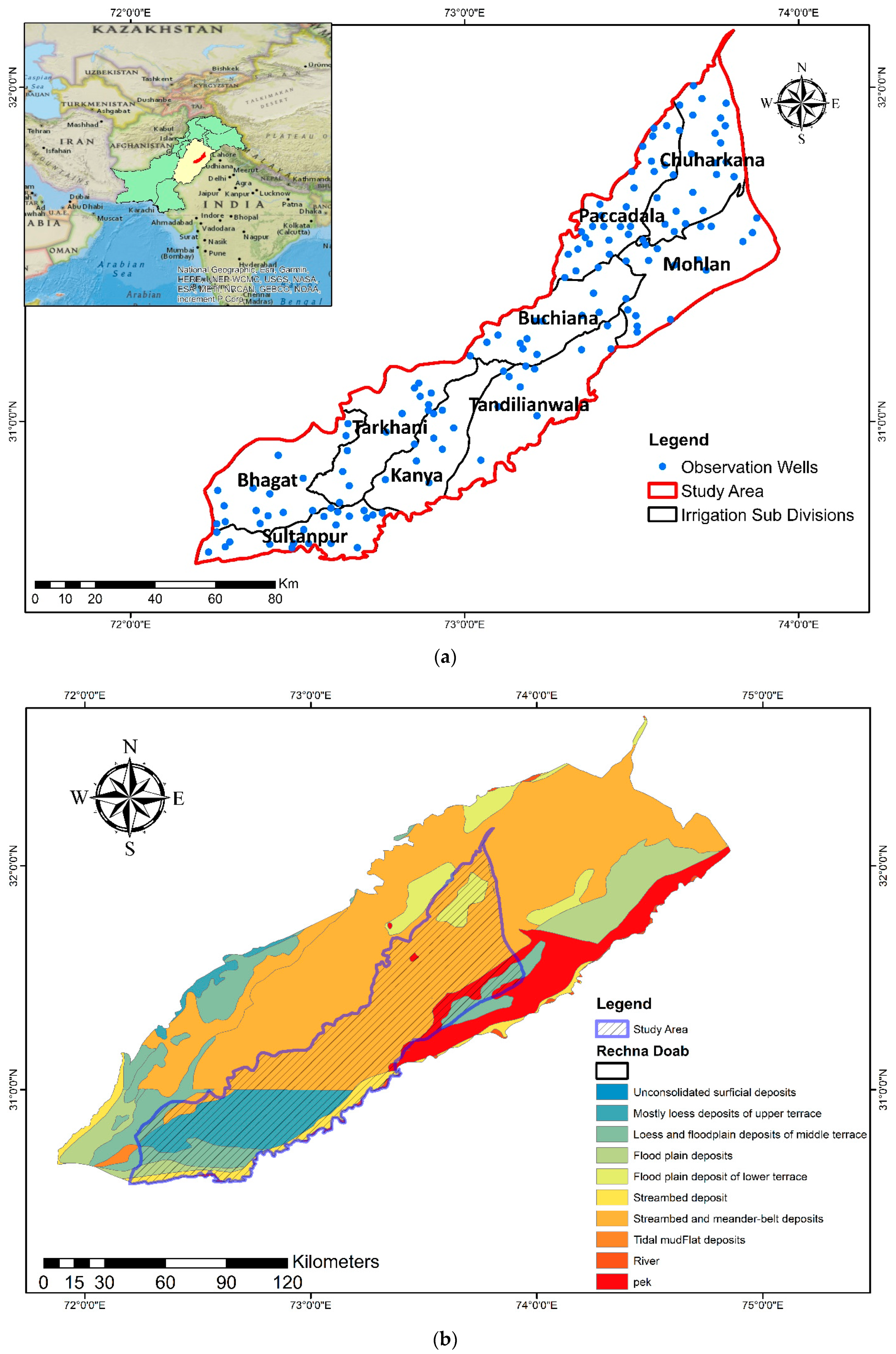
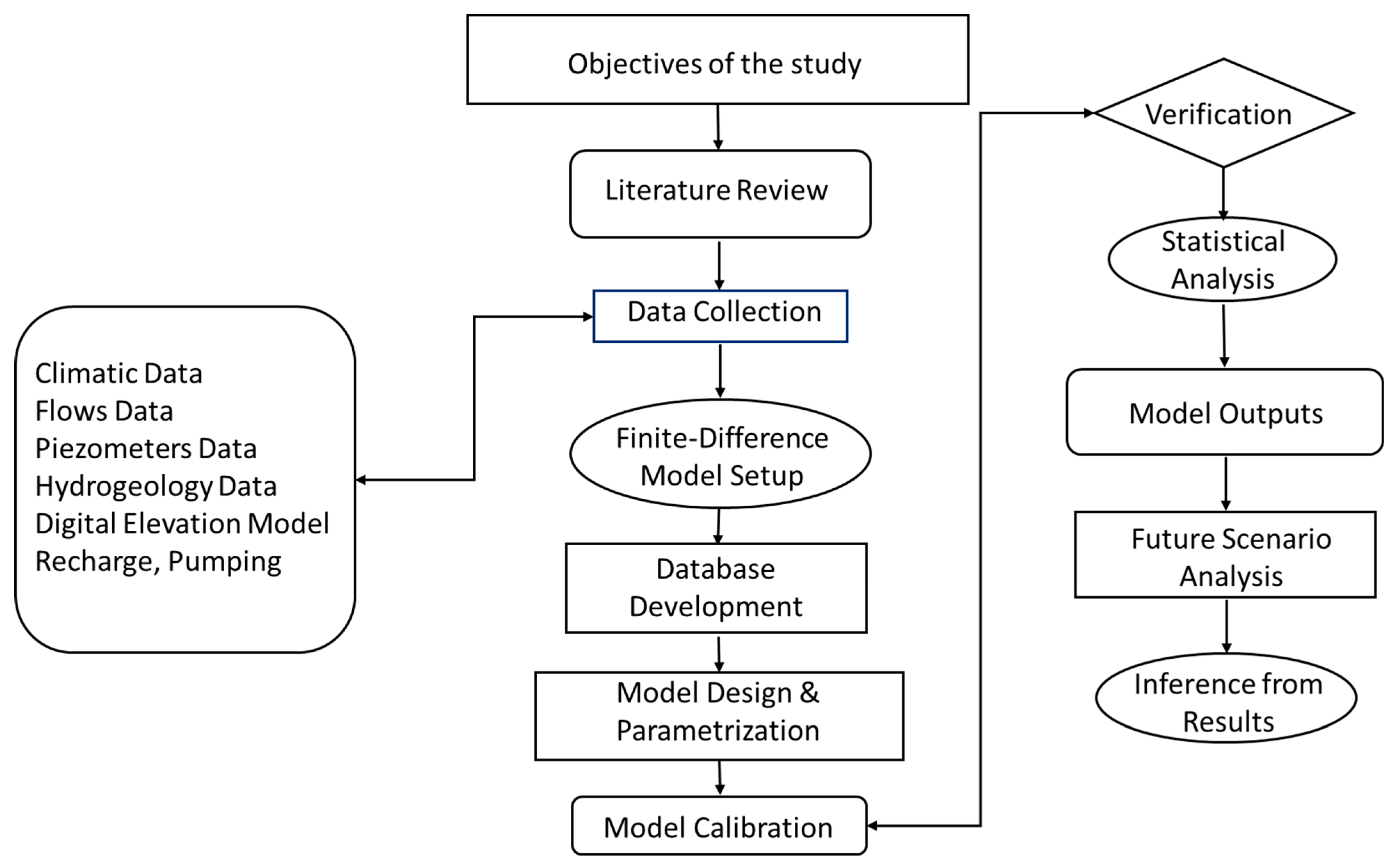
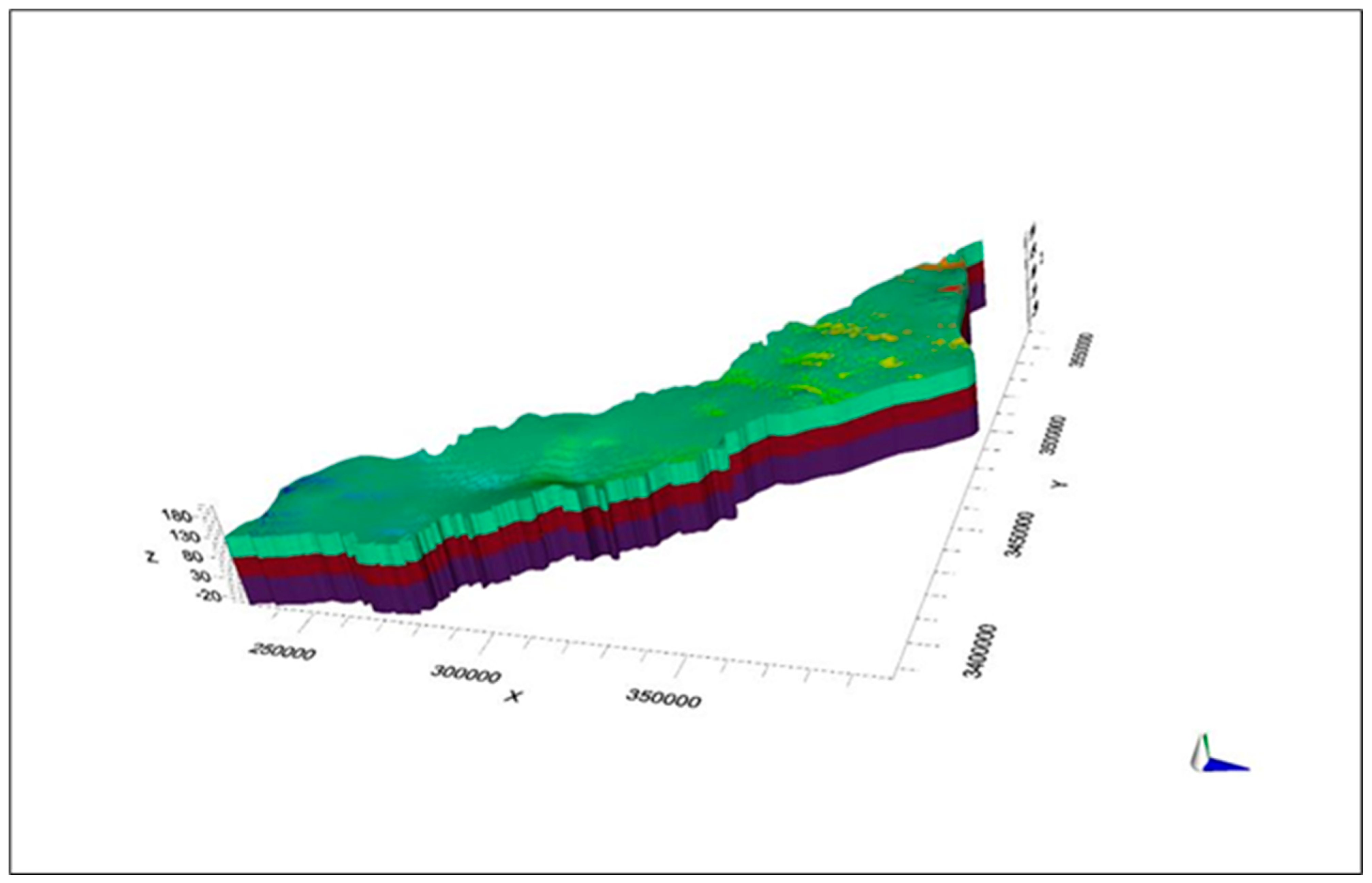



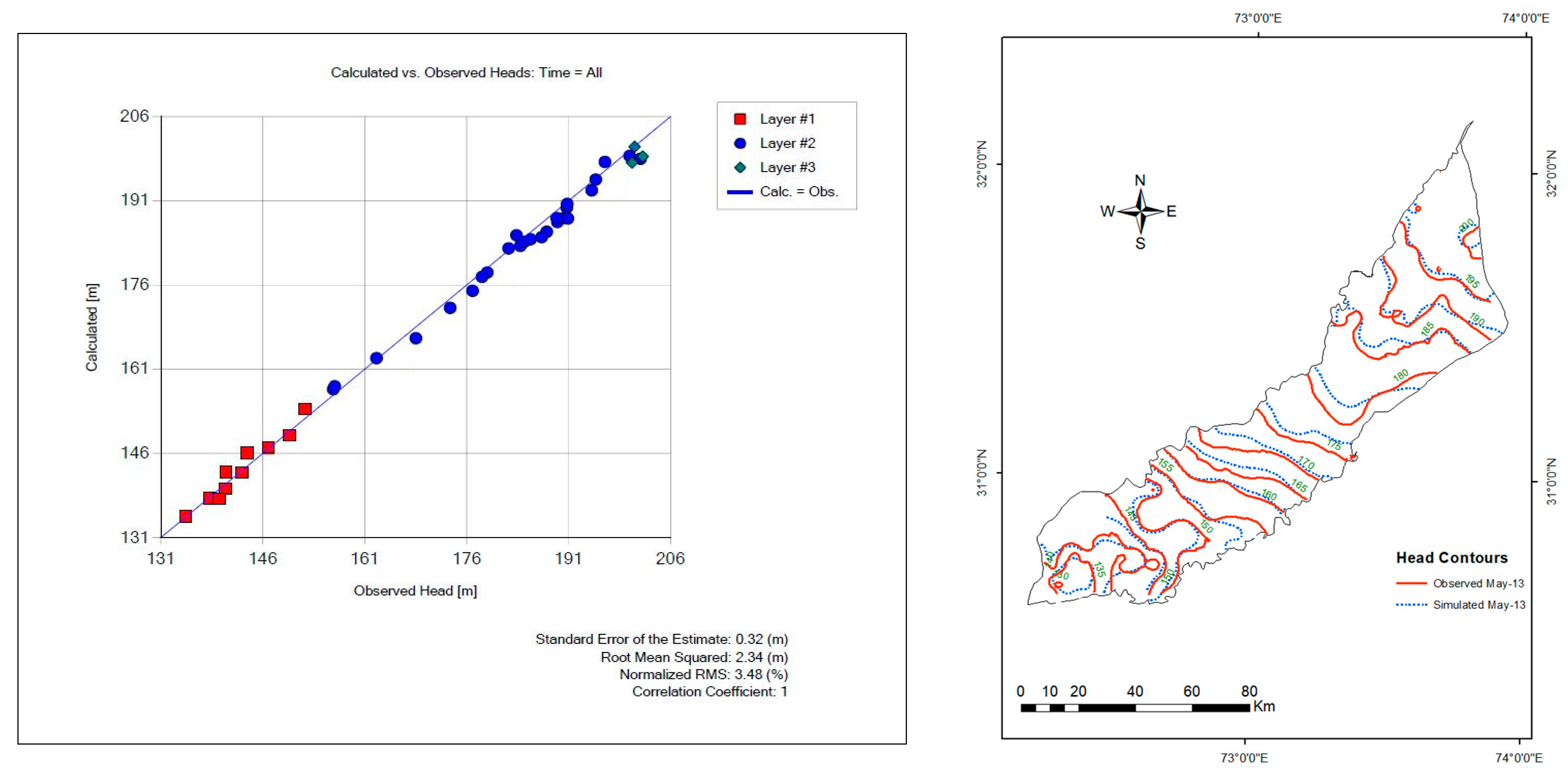
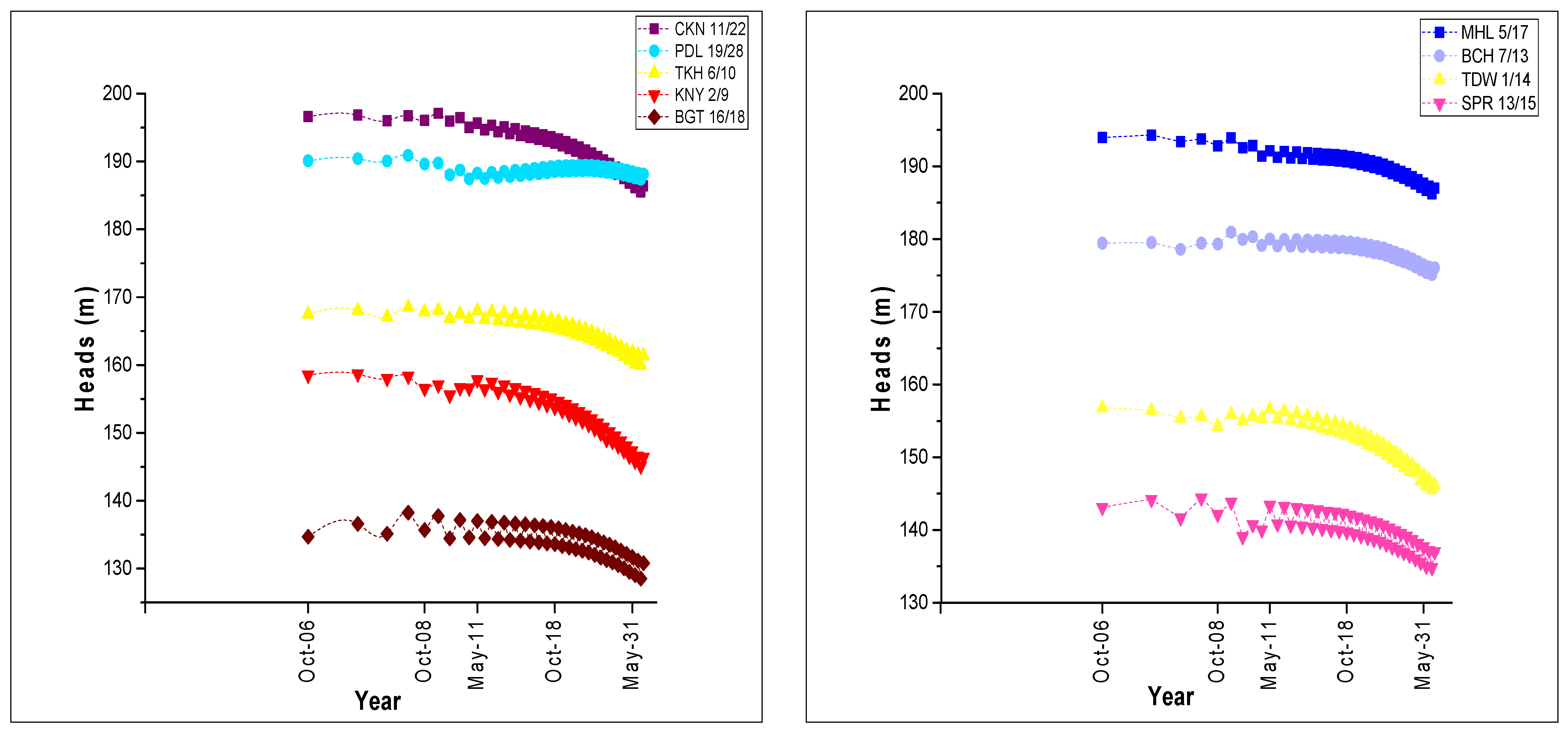




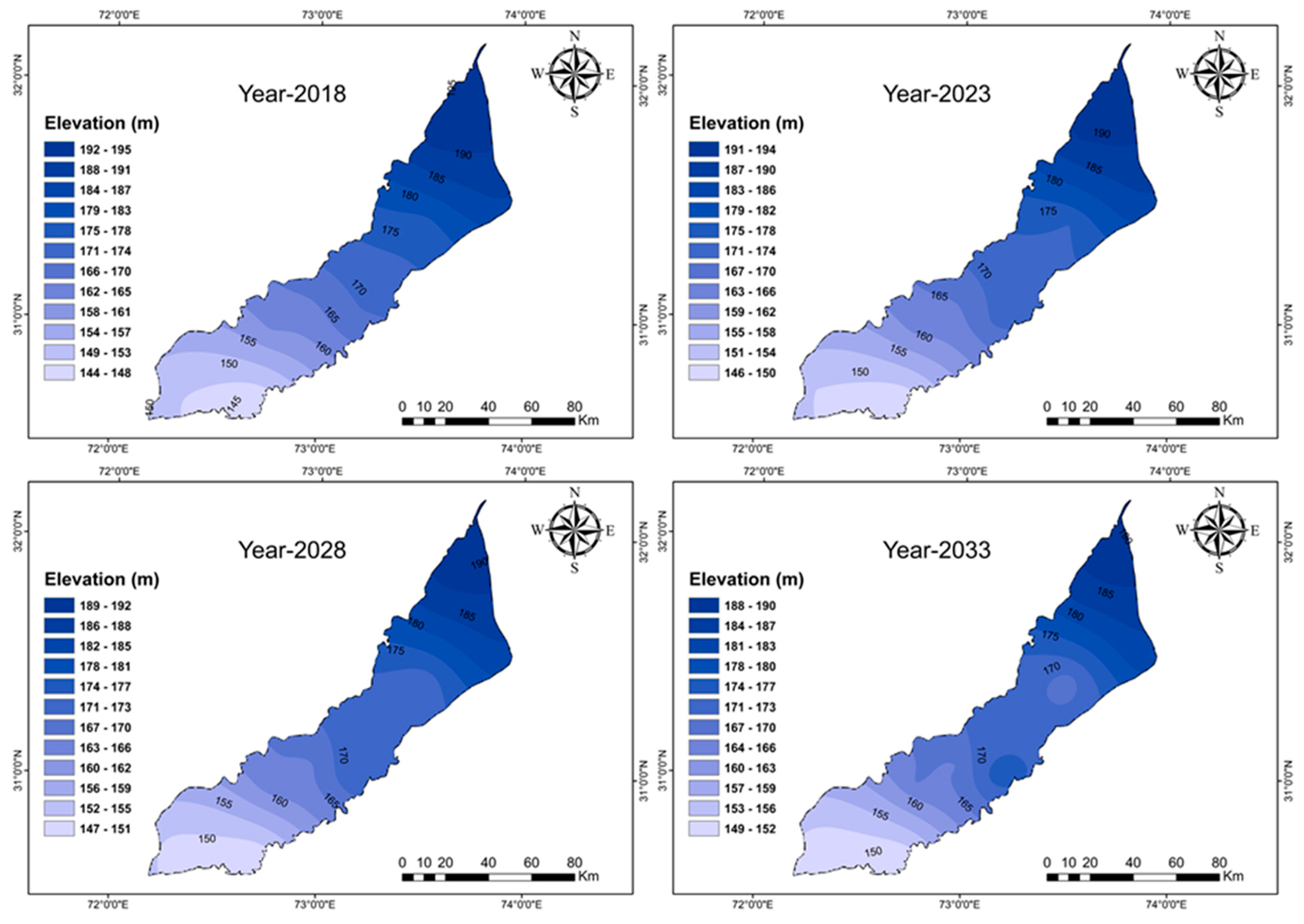
| Material Type | K (m/d) | Sy | Ss |
|---|---|---|---|
| Clay | 0.05 | 1.00 × 10−3 | 0.05 |
| Silty clay | 0.10 | 1.00 × 10−3 | 0.07 |
| Silty clay with sand | 1 | 1.00 × 10−3 | 0.10 |
| Clay with interbed of sand | 5 | 1.00 × 10−3 | 0.10 |
| Clay with gravel | 10 | 1.00 × 10−4 | 0.15 |
| Sand | 100 | 1.00 × 10−6 | 0.25 |
| Sand fine | 30 | 1.00 × 10−6 | 0.15 |
| Sand medium | 50 | 1.00 × 10−6 | 0.20 |
| Sand with silt | 30 | 1.00 × 10−5 | 0.20 |
| Sand coarse with gravel | 150 | 1.00 × 10−7 | 0.25 |
| Mixed sand and silt | 100 | 1.00 × 10−6 | 0.20 |
| Silt | 1 | 1.00 × 10−5 | 0.15 |
| Gravel | 200 | 1.00 × 10−7 | 0.25 |
| Year | SEE (m) | RMSE (m) | NRMS (%) | CC | MAE (m) | NS (%) | R2 |
|---|---|---|---|---|---|---|---|
| 2006 Steady State | 0.38 | 4.55 | 6.19 | 0.98 | 2.793 | 0.95 | 0.96 |
| 2006 Transient State | 0.15 | 1.84 | 2.48 | 0.99 | 1.327 | 0.99 | 0.98 |
| 2010 Transient State | 0.18 | 2.27 | 3.22 | 0.99 | 1.584 | 0.98 | 0.98 |
| 2013 Validation | 0.32 | 2.34 | 3.48 | 0.99 | 1.602 | 0.98 | 0.98 |
| Period | Scenario I | Scenario II | Scenario III | |||||||||
|---|---|---|---|---|---|---|---|---|---|---|---|---|
| Min | Max | Mean | SD | Min | Max | Mean | SD | Min | Max | Mean | SD | |
| 2013–2018 | −1.34 | 1.33 | −0.18 | 0.76 | −2.39 | 0.89 | −0.56 | 1.01 | −2.67 | 2.0 | −0.24 | 1.81 |
| 2013–2023 | −2.68 | 2.67 | −0.37 | 1.52 | −6.26 | −2.96 | −3.78 | 0.97 | −5.35 | 4.0 | −0.48 | 3.62 |
| 2013–2028 | −4.01 | 4.03 | −0.54 | 2.28 | −9.07 | −4.81 | −7.85 | 1.42 | −8.02 | 5.99 | −0.72 | 5.43 |
| 2013–2033 | −5.17 | 5.0 | −0.86 | 2.86 | −15.68 | −6.03 | −12.65 | 2.95 | −10.7 | 7.99 | −0.99 | 7.21 |
| Observation Well | Groundwater Level (m) | ||||||||
|---|---|---|---|---|---|---|---|---|---|
| 2013 | 2018 | Inc/Dec from 2013 | 2023 | Inc/Dec from 2013 | 2028 | Inc/Dec from 2013 | 2033 | Inc/Dec from 2013 | |
| CKN-11/22 | 195.38 | 194.58 | −0.8 | 193.78 | −1.6 | 192.98 | −2.4 | 192.2 | −3.18 |
| MHL-5/17 | 192.25 | 192.44 | 0.19 | 192.62 | 0.37 | 192.81 | 0.56 | 192.96 | 0.71 |
| PDL-19/28 | 188.85 | 190.18 | 1.33 | 191.52 | 2.67 | 192.88 | 4.03 | 193.85 | 5 |
| BCH-7/13 | 180.22 | 180.63 | 0.41 | 181.04 | 0.82 | 181.45 | 1.23 | 181 | 0.78 |
| TKH-6/10 | 167.93 | 167.62 | −0.31 | 167.31 | −0.62 | 166.99 | −0.94 | 166.5 | −1.43 |
| TDW-1/14 | 156.3 | 155.31 | −0.99 | 154.32 | −1.98 | 153.33 | −2.97 | 152.4 | −3.9 |
| KNY-2/9 | 157.37 | 156.03 | −1.34 | 154.69 | −2.68 | 153.36 | −4.01 | 152.2 | −5.17 |
| SPR-13/15 | 142.36 | 142.2 | −0.16 | 142.08 | −0.28 | 141.99 | −0.37 | 141.9 | −0.46 |
| BGT-16/18 | 137.1 | 137.09 | −0.01 | 137.06 | −0.04 | 137.03 | −0.07 | 137 | −0.1 |
| Observation Wells | Groundwater Level (m) | ||||||||
|---|---|---|---|---|---|---|---|---|---|
| 2013 | 2018 | Inc/Dec from 2013 | 2023 | Inc/Dec from 2013 | 2028 | Inc/Dec from 2013 | 2033 | Inc/Dec from 2013 | |
| CKN-11/22 | 197.23 | 196.16 | −1.07 | 193.36 | −3.87 | 192.42 | −4.81 | 191.2 | −6.03 |
| MHL-5/17 | 195.00 | 192.61 | −2.39 | 188.74 | −6.26 | 186.22 | −8.78 | 185.03 | −9.97 |
| PDL-19/28 | 188.05 | 188.24 | 0.19 | 184.5 | −3.55 | 178.98 | −9.07 | 173.01 | −15.04 |
| BCH-7/13 | 178.90 | 179.6 | 0.7 | 175.66 | −3.24 | 169.93 | −8.97 | 164.4 | −14.5 |
| TKH-6/10 | 166.77 | 167.66 | 0.89 | 163.7 | −3.07 | 158.07 | −8.7 | 152.1 | −14.67 |
| TDW-1/14 | 163.00 | 162.62 | −0.38 | 160.04 | −2.96 | 156.1 | −6.9 | 150.6 | −12.4 |
| KNY-2/9 | 160.59 | 160.15 | −0.44 | 156.99 | −3.6 | 152.22 | −8.37 | 146.3 | −14.29 |
| SPR-13/15 | 148.43 | 147.47 | −0.96 | 145.3 | −3.13 | 142.18 | −6.25 | 137.2 | −11.23 |
| BGT-16/18 | 142.18 | 140.6 | −1.58 | 137.81 | −4.37 | 133.4 | −8.78 | 126.5 | −15.68 |
| Observation Wells | Groundwater level (m) | ||||||||
|---|---|---|---|---|---|---|---|---|---|
| 2013 | 2018 | Inc/Dec from 2013 | 2023 | Inc/Dec from 2013 | 2028 | Inc/Dec from 2013 | 2033 | Inc/Dec from 2013 | |
| CKN-11/22 | 197.2 | 195.50 | −1.73 | 193.77 | −3.46 | 192.03 | −5.20 | 190.30 | −6.93 |
| MHL-5/17 | 195.0 | 192.35 | −2.65 | 189.70 | −5.30 | 187.05 | −7.95 | 184.40 | −10.6 |
| PDL-19/28 | 188.1 | 186.41 | −1.65 | 184.76 | −3.29 | 183.12 | −4.94 | 181.47 | −6.58 |
| BCH-7/13 | 178.9 | 176.23 | −2.67 | 173.55 | −5.35 | 170.88 | −8.02 | 168.20 | −10.7 |
| TKH-6/10 | 166.8 | 168.77 | 2.00 | 170.77 | 4.00 | 172.76 | 5.99 | 174.76 | 7.99 |
| TDW-1/14 | 163.0 | 163.73 | 0.73 | 164.47 | 1.47 | 165.20 | 2.20 | 165.93 | 2.93 |
| KNY-2/9 | 160.6 | 162.13 | 1.54 | 163.67 | 3.08 | 165.21 | 4.62 | 166.45 | 5.86 |
| SPR-13/15 | 148.4 | 148.99 | 0.56 | 149.55 | 1.12 | 150.11 | 1.68 | 150.67 | 2.24 |
| BGT-16/18 | 142.2 | 143.90 | 1.72 | 145.62 | 3.44 | 147.33 | 5.15 | 149.05 | 6.87 |
Disclaimer/Publisher’s Note: The statements, opinions and data contained in all publications are solely those of the individual author(s) and contributor(s) and not of MDPI and/or the editor(s). MDPI and/or the editor(s) disclaim responsibility for any injury to people or property resulting from any ideas, methods, instructions or products referred to in the content. |
© 2022 by the authors. Licensee MDPI, Basel, Switzerland. This article is an open access article distributed under the terms and conditions of the Creative Commons Attribution (CC BY) license (https://creativecommons.org/licenses/by/4.0/).
Share and Cite
Awais, M.; Arshad, M.; Ahmad, S.R.; Nazeer, A.; Waqas, M.M.; Aziz, R.; Shakoor, A.; Rizwan, M.; Chauhdary, J.N.; Mehmood, Q.; et al. Simulation of Groundwater Flow Dynamics under Different Stresses Using MODFLOW in Rechna Doab, Pakistan. Sustainability 2023, 15, 661. https://doi.org/10.3390/su15010661
Awais M, Arshad M, Ahmad SR, Nazeer A, Waqas MM, Aziz R, Shakoor A, Rizwan M, Chauhdary JN, Mehmood Q, et al. Simulation of Groundwater Flow Dynamics under Different Stresses Using MODFLOW in Rechna Doab, Pakistan. Sustainability. 2023; 15(1):661. https://doi.org/10.3390/su15010661
Chicago/Turabian StyleAwais, Muhammad, Muhammad Arshad, Sajid Rashid Ahmad, Aftab Nazeer, Muhammad Mohsin Waqas, Rizwan Aziz, Aamir Shakoor, Muhammad Rizwan, Junaid Nawaz Chauhdary, Qaisar Mehmood, and et al. 2023. "Simulation of Groundwater Flow Dynamics under Different Stresses Using MODFLOW in Rechna Doab, Pakistan" Sustainability 15, no. 1: 661. https://doi.org/10.3390/su15010661
APA StyleAwais, M., Arshad, M., Ahmad, S. R., Nazeer, A., Waqas, M. M., Aziz, R., Shakoor, A., Rizwan, M., Chauhdary, J. N., Mehmood, Q., & Ahmad, M. (2023). Simulation of Groundwater Flow Dynamics under Different Stresses Using MODFLOW in Rechna Doab, Pakistan. Sustainability, 15(1), 661. https://doi.org/10.3390/su15010661







